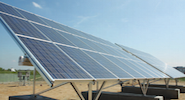Community Solar is coming
[Special thanks to Tobi Ogunnaike, one of our 2015 MD SUN summer fellows, who contributed this article and thanks to Erin Johnson for her editorial feedback.]
this article and thanks to Erin Johnson for her editorial feedback.]
In 2016, installing a solar system on your roof will no longer be the only way to “go solar” in Maryland. Right now you may be part of the majority that can’t install solar on your own roof because:
- Your rooftop faces the wrong way or has too much shade
- You’re renting a house or apartment
- You live in a condo and share the roof
- You don’t like the look of solar panels or can’t cut down your trees
- You can’t afford it
Historically, there have been efforts like the University Park Solar LLC, and the Greenbelt Community Solar, LLC that allowed individuals to invest in and benefit from a shared solar array at another location. These innovative, private efforts were successful but proved difficult to set up and scale. They also didn’t provide credits that show up directly on your electric bill.
Thanks to new legislation passed in May of 2015, you don’t need to install panels on your own roof to see solar credited on your electricity bill. That’s because community solar will allow you to receive the benefits of solar from a remotely located community solar array. These arrays are also called solar gardens.
How it works
With community solar, you’ll get credit on your electric bill for energy produced at an off-site community solar array or garden located in your area. In return for purchasing shares or subscriptions, you’ll earn credit for that solar energy on your utility bills. And you don’t have to worry about any repairs or maintenance; the solar developer handles that.
There are different variations of community solar but the underlying concept is the same: make solar available to all Maryland residents.
Community solar is available in 13 states, including California, Colorado, and Minnesota. Next summer, Maryland will begin a three-year pilot program.
MD SUN is participating in the pilot program alongside other solar stakeholders in the Public Service Commission’s (PSC) rule making process (that’s what happens to make legislation into regulations). Throughout the fall the working group met weekly to develop the rules for the pilot. These rules are based on the language of the legislation and the input from the working group.
Our goal is to help shape the regulations that will allow all Marylanders to participate in community solar and reap the cost-saving and environmental benefits.
The output of the PSC’s working group are draft regulations submitted to the PSC staff and entered into the official record as the starting point for public proceedings. On December 4th comments on these draft regulations are due to the commission to be entered into the administrative docket. On December 14th (and possibly 15th) the PSC will hold public sessions reviewing the draft regulations and in consideration of submitted comments. Submitting comments is a good opportunity for the general public to express their support for community solar in Maryland.
How you can act (Updated 12/4/2015)
Thanks to everyone who submitted comments to the Public Service Commission in the first week of December, 2015! There will be other opportunities to voice your support in the coming months. In the meantime here are two things you can do:
- Sign up for community solar updates
- Show your interest for subscribing to community solar when it’s available
